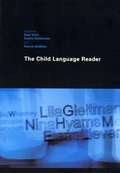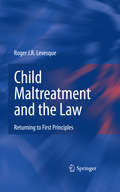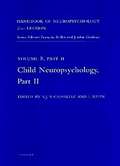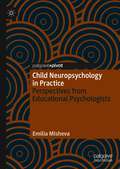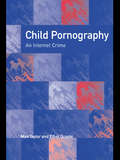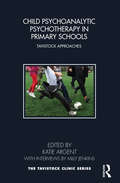- Table View
- List View
The Child Language Reader (PDF)
by Kate Trott Sushie Dobbinson Patrick GriffithsThe Child Language Reader provides an introduction to the most important research in child language acquisition and development. Including extensive editorial introductions, which explain key background, assumptions and terminology, and organized into thematic sections, it brings the reader into direct contact with original research, in a supported and guided environment. Features include: *articles written by a range of international authors, including classics by influential figures *coverage of a number of language development areas, including phonology, semantics, sociolinguistics, methodology and bilingualism *a substantial section on methodology, offering practical insight into the design of child language research *an appendix on statistical analysis *a new piece by Brian Richards and David Malvern. Covering a range of different theoretical standpoints, The Child Language Reader offers a comprehensive overview of the field, and is a definitive resource for anyone with an interest in child language.
Child Maltreatment: Expanding Our Concept of Helping
by Michael Rothery Gary CameronRecognizing child maltreatment as a complex phenomenon requiring multifaceted responses, this volume provides a current and comprehensive assessment of the problem, and argues for an expanded conception of helping on the part of those who work with maltreated children, their families, and their communities. Contributions follow a general outline that addresses current theory and models of practice, and empirical knowledge regarding the problem, intervention, and outcomes. Presenting and up-to- date and encompassing view of how to combat child abuse and neglect, this book discusses the concerns of service providers as well as academics. All the prevalent ways of responding to child maltreatment are addressed, and each is discussed in terms of theory, implementation and evidence for its effectiveness. For use as an undergraduate or graduate level text for courses in child welfare, sociology, family studies, and community psychology. This text would also be insightful for professionals, academics, and policymakers concerned with child welfare.
Child Maltreatment: Expanding Our Concept of Helping
by Michael Rothery Gary CameronRecognizing child maltreatment as a complex phenomenon requiring multifaceted responses, this volume provides a current and comprehensive assessment of the problem, and argues for an expanded conception of helping on the part of those who work with maltreated children, their families, and their communities. Contributions follow a general outline that addresses current theory and models of practice, and empirical knowledge regarding the problem, intervention, and outcomes. Presenting and up-to- date and encompassing view of how to combat child abuse and neglect, this book discusses the concerns of service providers as well as academics. All the prevalent ways of responding to child maltreatment are addressed, and each is discussed in terms of theory, implementation and evidence for its effectiveness. For use as an undergraduate or graduate level text for courses in child welfare, sociology, family studies, and community psychology. This text would also be insightful for professionals, academics, and policymakers concerned with child welfare.
Child Maltreatment and the Law: Returning to First Principles
by Roger J.R. LevesqueDramatic cases of child abuse and neglect are featured with tragic regularity in the news. The stories vividly demonstrate both the urgent need for improved child protection services and the unwieldiness and ineffectiveness of the systems charged with the task. To complicate matters further, the original intent of child welfare policy is becoming increasingly obscured as legal responses to child maltreatment become more complex, intrusive, and even contradictory. Fueled by a consistent narrative and a lucid ethical stance, Child Maltreatment and the Law analyzes the increasing role legal systems play in family life and traces rapidly evolving legal concepts as they apply to child protection. This unique volume helps readers: (1) Navigate the various layers of legal regulation – federal and state – involved in child protection and family life. (2) Identify variations and discrepancies in definitions of maltreatment and legal responses. (3) Critique the relationships and boundary disputes between the criminal and civil justice systems and agencies dedicated to children’s welfare. (4) Analyze controversies (e.g., removing children from maltreating families) and other prime areas for possible reform. Child Maltreatment and the Law is a must-read for psychologists, developmentalists, sociologists, social workers, criminologists, and researchers focusing on family life as well as policymakers and advocates working within the legal system. The book is particularly useful for courses relating to child welfare law or child abuse and neglect.
Child Maltreatment Fatalities in the United States: Four Decades of Policy, Program, and Professional Responses
by Emily M. DouglasThis book focuses on the prevention of child abuse and neglect deaths in the U.S. In 2013 1,520 children died from maltreatment. This book defines child maltreatment fatalities (CMFs) and discusses the prevalence of deaths in the U.S. over the last several decades. It addresses the known risk factors for maltreatment deaths including child, parent, the parent-child relationship, and household risk factors. The main focus of the book addresses the responses and interventions that have been put in place in order to prevent CMFs: the child welfare profession, child death review teams, safe haven laws, criminal justice responses, public education, and new, federal efforts in the U.S. to reduce CMFs in the U.S. The book finishes by making recommendations for researchers, practitioners, and decision-makers about how to prevent fatal maltreatment among children in the U.S.
Child Maltreatment in Residential Care: History, Research, and Current Practice
by Adrian V. Rus Sheri R. Parris Ecaterina StativaThis data-rich volume reviews short- and long-term consequences of residential or institutional care for children across the globe as well as approaches to reducing maltreatment. Up-to-date findings from a wide range of developing and developed countries identify forms of abuse and neglect associated with institutionalization and their effects on development and pathology in younger children, adolescents, and alumni. The sections on intervention strategies highlight the often-conflicting objectives facing professionals and policymakers balancing the interests of children, families, and facilities. But despite many national and regional variations, two themes stand out: the universal right of children to live in safety, and the ongoing need for professionals and community to ensure this safety.Included among the topics:Maltreatment and living conditions in long-term residential institutions for childrenOutcomes from institutional rearingRecommendations to improve institutional livingHistorical, political, socio-economic, and cultural influences on Child Welfare SystemsLatin American and the Caribbean, African, Asian, Middle-Eastern, Western and Eastern European countries and the United States of America are presented.Child Maltreatment in Residential Care will inform psychology professionals interested in the role of residential care in the lives of children, and possibilities for improved outcomes. It will also interest social workers and mental health practitioners and researchers seeking evidence-based interventions for families adopting children from residential care.
Child Maltreatment Research, Policy, and Practice: Contributions of Penelope K. Trickett (SpringerBriefs in Psychology)
by Sonya NegriffThe brief provides an overview of Dr. Penelope K. Trickett’s work and explores her innovations in the areas of theory, measurement, and methodology in the study of child maltreatment. It offers a summary of Dr. Trickett’s seminal longitudinal studies on child maltreatment, including their influence on understanding the impact of sexual abuse and child maltreatment on female and adolescent development. Chapters examine the impact of her work on policy and practice and offer present four new empirical studies that have been directly influenced by Dr. Trickett’s contributions. The brief concludes with further research recommendations to bridge the current policy and practice gaps. Topics featured in this brief include:Childhood sexual abuse and its effect on eating disorder development in females.The traumatic nature of reporting maltreatment in adolescents.Associations between adolescents’ community violence exposure (CVE) and the development of aggressive behavior problems. Child sexual abuse experiences in Korea. Child Maltreatment Research, Policy, and Practice is a must-have resource for policy makers and related professionals, graduate students, and researchers in child and school psychology, family studies, public health, social work, law/criminal justice, and sociology.
Child Mental Health: Exploring Systems of Care in the New Millennium
by John Y Powell David Dosser Dorothea Handron Susan Mccammon Sandra A. SpencerUse these system-of-care concepts to better serve children with serious emotional problems and their families!Providing services to children with emotional problems and their families continues to be a major challenge for social workers, family therapists, child mental health advocates, and psychologists in the new century. This valuable book addresses that challenge, detailing theory, principles, and application issues from the vantage points of both consumers and service providers. System-of-care values and practices were developed to address these concerns and meet the needs of these children and families, who tend to receive either no services at all or services that are far too restrictive, at a large cost to the organization providing the services.Child Mental Health: Exploring Systems of Care in the New Millennium identifies salient issues and offers suggestions for addressing the complexities of providing services for these troubled families. It also provides hope and encouragement for family members and professionals by identifying roles and practices that are effective in building collaborative community-based services.This book takes an incisive look at: the benefits and difficulties of partnering between practitioners and families the need for and benefits of partnering between practitioners of various disciplines within the system of care a working model of a wraparound process (the hallmark of the system of care) barriers that prevent effective wraparound services and what causes them the need to help social workers learn parent partnering skills the roles that families can play in the system of care the need for specialized training so that practitioners can learn to assess, understand, and integrate a family's spiritual beliefs into the system of care the development of an interdisciplinary, collaborative practice course at East Carolina University experiential training and shared-classroom experiences for studentsChild Mental Health: Exploring Systems of Care in the New Millennium is a tool that will aid practitioners and consumers alike as they shift their point of view from the provider-as-expert paradigm to one of building partnerships.
Child Mental Health: Exploring Systems of Care in the New Millennium
by John Y Powell David Dosser Dorothea Handron Susan Mccammon Sandra A. SpencerUse these system-of-care concepts to better serve children with serious emotional problems and their families!Providing services to children with emotional problems and their families continues to be a major challenge for social workers, family therapists, child mental health advocates, and psychologists in the new century. This valuable book addresses that challenge, detailing theory, principles, and application issues from the vantage points of both consumers and service providers. System-of-care values and practices were developed to address these concerns and meet the needs of these children and families, who tend to receive either no services at all or services that are far too restrictive, at a large cost to the organization providing the services.Child Mental Health: Exploring Systems of Care in the New Millennium identifies salient issues and offers suggestions for addressing the complexities of providing services for these troubled families. It also provides hope and encouragement for family members and professionals by identifying roles and practices that are effective in building collaborative community-based services.This book takes an incisive look at: the benefits and difficulties of partnering between practitioners and families the need for and benefits of partnering between practitioners of various disciplines within the system of care a working model of a wraparound process (the hallmark of the system of care) barriers that prevent effective wraparound services and what causes them the need to help social workers learn parent partnering skills the roles that families can play in the system of care the need for specialized training so that practitioners can learn to assess, understand, and integrate a family's spiritual beliefs into the system of care the development of an interdisciplinary, collaborative practice course at East Carolina University experiential training and shared-classroom experiences for studentsChild Mental Health: Exploring Systems of Care in the New Millennium is a tool that will aid practitioners and consumers alike as they shift their point of view from the provider-as-expert paradigm to one of building partnerships.
Child Neuropsychology: Concepts, Theory, and Practice
by Jonathan Reed Jody Warner-RogersBased on the most up-to-date research, Child Neuropsychology is a thorough and accessible guide to the key concepts and basic processes central to neuropsychological assessment and child evaluation. Essays by leading experts in the field cover basic neuropsychological functions and related disorders in the context of brain development. Divided into three parts, the text begins with clear definitions of the concepts and methodology of brain development in child neuropsychology. Part two examines normal and abnormal functional development. The final part considers professional practice and provides valuable insights into the special problems of neuropsychological assessment of infants and children in clinical and educational settings.
Child Neuropsychology (Handbook Of Neuropsychology Ser. #8 (PDF))
by S. J. SegalowitzVolume 8 consists of Parts I and II. Part I considers theoretical perspectives in bridging developmental neuroscience with child psychology, with the role of neuroscience furthering our understanding of the child?s mental development, and a separate chapter outlines the importance of plasticity in this growth. Chapters also cover methodological issues arising from epidemiological perspectives and from psychometric concepts and issues. Methods for measuring biological brain function and structure and their particular application to child neuropsychological disorders are covered next, including ERP, PET, SPECT, MRI and fMRI technologies. Included is a chapter devoted to childhood seizure disorders. Separate chapters follow on neuropsychological assessment in infancy, in the preschool child, and in school-aged children. Following this are presentations on the development of motor control, including handedness, and somatosensory perception. Part II begins with chapters on visual development and on development in visually impaired children, followed by chapters on cognitive development in deaf children and on central auditory functions and their evaluation. This is followed by chapters on early language development and its neural correlates, developmental language disorders, and on acquired aphasia in childhood. Two chapters on dyslexia and another on dyscalculia follow. Next is a chapter on disorders of memory with a special focus on temporal lobe disease and autism, one on attention disorders, and one on executive functions in normal and abnormal development. Following this are chapters on the development of emotional regulation and on mechanisms and influences on addiction in children and adolescents. Final chapters include one on eating disorders, and another focussing on autism spectrum disorders.
Child Neuropsychology: Assessment and Interventions for Neurodevelopmental Disorders, 2nd Edition
by Margaret Semrud-Clikeman Phyllis Anne Teeter EllisonDuring the past decade, significant advances have been made in the field of neurodevelopmental disorders, resulting in a considerable impact on conceptualization, diagnostics, and practice. The second edition of Child Neuropsychology: Assessment and Interventions for Neurodevelopmental Disorders brings readers up to speed clearly and authoritatively, offering the latest information on neuroimaging technologies, individual disorders, and effective treatment of children and adolescents. Starting with the basics of clinical child neuropsychology and functional anatomy, the authors present a transactional framework for assessment, diagnosis, and intervention. The book carefully links structure and function—and behavioral and biological science—for a more nuanced understanding of brain development and of pathologies as varied as pervasive developmental disorders, learning disabilities, neuromotor dysfunction, seizure disorders, and childhood cancers. This volume features a range of salient features valuable to students as well as novice and seasoned practitioners alike, including: Overview chapters that discuss the effects of biogenic and environmental factors on neurological functioning. New emphasis on multicultural/cross-cultural aspects of neuropsychology and assessment. Brand new chapters on interpretation, neuropsychological assessment process, and report writing. An integrative model of neurological, neuroradiological, and psychological assessment and diagnosis. Balanced coverage of behavioral, pharmacological, and educational approaches to treatment. Case studies illustrating typical and distinctive presentations and successful diagnosis, treatment planning, and intervention. Important practice updates, including the new HIPAA regulations. Child Neuropsychology, 2nd Edition, is vital reading for school, clinical child, and counseling psychologists as well as neuropsychologists. The book also provides rich background and practical material for graduate students entering these fields.
Child Neuropsychology: Assessment and Interventions for Neurodevelopmental Disorders
by Phyllis Anne Teeter Ellison Margaret Semrud-ClikemanChild Neuropsychology guides therapists and neurologists toward common goals: early, accurate diagnosis and finely focused interventions across disciplines. This groundbreaking volume brings vital perspectives to assessment and treatment. For clinical child practitioners as well as for advanced students, this book contains the essential tools needed to meet the complex challenges of diagnosing and treating brain-based illnesses.
Child Neuropsychology in Practice: Perspectives from Educational Psychologists
by Emilia MishevaThis book examines the relationship between educational psychology and neuropsychology. It is based on the findings from two original research studies – a national survey looking at educational psychologists’ views on neuropsychology; and interviews exploring the specialist role of educational psychologists in neuropsychological settings. The book considers key questions such as: Is neuropsychology applicable to educational psychologists’ day-to-day practice, or is it primarily a specialism? What is the role and unique contribution of educational psychologists working in child neuropsychological settings? Why are educational psychologists underrepresented amongst neuropsychologists and what does the training route entail? The book also considers why neuro-based concepts are so appealing to educators and the general public and explores the most prevalent misconceptions and neuromyths in education. Overall, the book aims to provide a unified account of the complex relationship between the disciplines through the voice of educational psychologists themselves and challenges some of the misconceptions about child neuropsychology as a specialism.
Child Nurturance: Studies of Development in Nonhuman Primates (Child Nurturance #3)
by PatriciaGage John A. Mullins Hiram E. FitzgeraldThe underlying theme uniting the papers of this volume is the quest for a further understanding of human behavior. The similarities between the behaviors of other primates and humans have captivated us even before a science arose. But what is the justification for making such comparisons? Comparisons, like classifications, can be made on any basis whatever. The aim in making any scientific comparison is the same as doing a classification. That is, one attempts to make the comparison on a "natural" basis. Natural, in this case, means that the comparison reflects processes that occur in nature. The fundamental paradigm for making natural comparisons in biology is based on evolutionary theory. The evolutionary paradigm is inherently one of comparisons between and within species. Conversely, it is impossible to begin to make cross species comparisons without making, implicitly at least, evolutionary arguments. But evolution is a complex construct of theories (Lewis, 1980), and comparisons can be made out of different theoretical bases. F or the sake of this discussion we can combine varieties of sub-theories into two categories: those having to do with descent with modification, and those concerned with the mechanics of evolutionary change--notably natural selection.
Child Nurturing in the 1980s: Child Nurturing In The 1980s (Child Nurturance #4)
by Robert P. Boger Gaston E. Blom Larry E. LezotteChild Nurturing in the 1980s follows upon aseries of lectures presented at Michigan State University in conjunction with the uni versity's celebration of the International Year of the Child. The chapters, although far from an inc1usive set, outline childrearing perspectives, issues and concerns relevant to the 80s and beyond. The authors have used different styles ranging from empirical review to essay. The book is designed to provide those concerned with the nurturing of children in the United States with perceptions of what is and what could be. The initial chapter by Edward Zigler sets the stage for comments related to specific areas and modalities of child nurturing concerns for the decade. Some of the chapter authors are more futuristic than others in their perspective, but all have focused upon issues judged to be focal for those concerned with the nurturing of children in this culture during this period of our history • The book is not addressed specifically to those who would set policy or those who would implement it. Rather , it is hoped that it can be read with benefit by a wide range of individuals inc1uding but not limited to parents, faculty members, child care workers and child agency personnei. The editors wish to extend our appreciation to many individuals who made this effort possible. Funding of the IYC program was provided through the International Year of the Child Committee under the most able leadership of Andrew D. Hunt, M. D.
Child-Parent Relationship Therapy (CPRT): An Evidence-Based 10-Session Filial Therapy Model
by Garry L. Landreth Sue C. BrattonChild-Parent Relationship Therapy (CPRT), grounded in the attitudes and principles of Child-Centered Play Therapy (CCPT), is based on the belief that a parent acting as an agent for change in place of a play therapist has potential for significant and lasting therapeutic gains. This newly expanded and revised edition of Child-Parent Relationship Therapy (CPRT) describes training objectives, essential skills and concepts taught in each session, as well as the format for supervising parents’ play sessions. Transcripts of actual sessions demonstrate process and content in the 10 CPRT training sessions. Research demonstrating the effectiveness of CPRT on child and parent outcomes is presented in support of CPRT’s designation as an evidence-based treatment model. This second edition is updated to include six new chapters exploring the topics of cultural considerations for working with ethnically and racially diverse families, neuroscience support for CPRT, and adaptions for specific populations including parents of toddlers, parents of preadolescents, adoptive families, and the teacher/student relationship. The authors’ expertise and experience results in a book that is essential reading for both students and professionals. By using this text and the accompanying treatment manual, filial therapists will have a complete package for training parents in the CPRT model.
Child-Parent Relationship Therapy (CPRT): An Evidence-Based 10-Session Filial Therapy Model
by Garry L. Landreth Sue C. BrattonChild-Parent Relationship Therapy (CPRT), grounded in the attitudes and principles of Child-Centered Play Therapy (CCPT), is based on the belief that a parent acting as an agent for change in place of a play therapist has potential for significant and lasting therapeutic gains. This newly expanded and revised edition of Child-Parent Relationship Therapy (CPRT) describes training objectives, essential skills and concepts taught in each session, as well as the format for supervising parents’ play sessions. Transcripts of actual sessions demonstrate process and content in the 10 CPRT training sessions. Research demonstrating the effectiveness of CPRT on child and parent outcomes is presented in support of CPRT’s designation as an evidence-based treatment model. This second edition is updated to include six new chapters exploring the topics of cultural considerations for working with ethnically and racially diverse families, neuroscience support for CPRT, and adaptions for specific populations including parents of toddlers, parents of preadolescents, adoptive families, and the teacher/student relationship. The authors’ expertise and experience results in a book that is essential reading for both students and professionals. By using this text and the accompanying treatment manual, filial therapists will have a complete package for training parents in the CPRT model.
Child-Parent Relationship Therapy (CPRT) Treatment Manual: An Evidence-Based 10-Session Filial Therapy Model
by Sue C. Bratton Garry L. LandrethThis newly expanded and revised edition of the Child-Parent Relationship Therapy (CPRT) Treatment Manual is the essential companion to the second edition of Child-Parent Relationship Therapy (CPRT). The second edition is updated to include four new CPRT treatment protocols and parent notebooks adapted for specific populations: parents of toddlers, parents of preadolescents, adoptive families, and the teacher/student relationship, along with the revised original CPRT protocol and parent notebook for ages 3−10. This manual provides the CPRT/filial therapist a comprehensive framework for conducting CPRT. Included are detailed outlines, teaching aides, activities, and resources for each of the 10 sessions. The manual is divided into two major sections, Therapist Protocol and Parent Notebook, and contains a comprehensive CPRT Training Resources section along with an index to the accompanying Companion Website. The accompanying Companion Website contains all necessary and supplemental training materials in a format that allows for ease of reproduction and enhanced usability including the following: CPRT Protocol—Ages 3 to 10 and Parent Notebook Toddler Adapted CPRT Protocol and Parent Notebook Preadolescent Adapted CPRT Protocol and Parent Notebook Adoptive Families Adapted CPRT Protocol and Parent Notebook Teacher/Student Adapted Protocol and Teacher Notebook Therapist Study Guide Training Resources, Teaching Aides and Supplemental Materials Marketing Materials Assessments Drawing on their extensive experience as professional play therapists and filial therapists, Bratton and Landreth apply the principles of CCPT and CPRT in this easy-to-follow protocol for practitioners to successfully implement the evidence-based CPRT model. By using this manual and the accompanying Companion Website in conjunction with the CPRT text, filial therapists will have a complete package for training parents in CCPT skills to act as therapeutic agents with their own children.
Child-Parent Relationship Therapy (CPRT) Treatment Manual: An Evidence-Based 10-Session Filial Therapy Model
by Sue C. Bratton Garry L. LandrethThis newly expanded and revised edition of the Child-Parent Relationship Therapy (CPRT) Treatment Manual is the essential companion to the second edition of Child-Parent Relationship Therapy (CPRT). The second edition is updated to include four new CPRT treatment protocols and parent notebooks adapted for specific populations: parents of toddlers, parents of preadolescents, adoptive families, and the teacher/student relationship, along with the revised original CPRT protocol and parent notebook for ages 3−10. This manual provides the CPRT/filial therapist a comprehensive framework for conducting CPRT. Included are detailed outlines, teaching aides, activities, and resources for each of the 10 sessions. The manual is divided into two major sections, Therapist Protocol and Parent Notebook, and contains a comprehensive CPRT Training Resources section along with an index to the accompanying Companion Website. The accompanying Companion Website contains all necessary and supplemental training materials in a format that allows for ease of reproduction and enhanced usability including the following: CPRT Protocol—Ages 3 to 10 and Parent Notebook Toddler Adapted CPRT Protocol and Parent Notebook Preadolescent Adapted CPRT Protocol and Parent Notebook Adoptive Families Adapted CPRT Protocol and Parent Notebook Teacher/Student Adapted Protocol and Teacher Notebook Therapist Study Guide Training Resources, Teaching Aides and Supplemental Materials Marketing Materials Assessments Drawing on their extensive experience as professional play therapists and filial therapists, Bratton and Landreth apply the principles of CCPT and CPRT in this easy-to-follow protocol for practitioners to successfully implement the evidence-based CPRT model. By using this manual and the accompanying Companion Website in conjunction with the CPRT text, filial therapists will have a complete package for training parents in CCPT skills to act as therapeutic agents with their own children.
Child Pornography: An Internet Crime
by Ethel Quayle Max TaylorChild pornography, particularly that available via the Internet, has become a cause of huge social concern in recent years. This book examines the reality behind the often hysterical media coverage of the topic. Drawing on extensive new research findings, it examines how child pornography is used on the Internet and the social context in which such use occurs, and develops a model of offending behaviour to better help understand and deal with the processes of offending. Detailed case studies and offenders' own accounts are used to illustrate the processes involved in offending and treatment.The authors argue that we need to refine our ideas of offending, and that while severe deterrents need to be associated with possession of child pornography, a better understanding is needed of the links between possession and committing a contact offence. Only by improving our understanding of this complex and very controversial topic can we hope to deal effectively with offenders and with their child victims. This is a book which will become an essential read for anyone involved with offenders or victims from a psychological, judicial or social background.
Child Pornography: An Internet Crime
by Ethel Quayle Max TaylorChild pornography, particularly that available via the Internet, has become a cause of huge social concern in recent years. This book examines the reality behind the often hysterical media coverage of the topic. Drawing on extensive new research findings, it examines how child pornography is used on the Internet and the social context in which such use occurs, and develops a model of offending behaviour to better help understand and deal with the processes of offending. Detailed case studies and offenders' own accounts are used to illustrate the processes involved in offending and treatment.The authors argue that we need to refine our ideas of offending, and that while severe deterrents need to be associated with possession of child pornography, a better understanding is needed of the links between possession and committing a contact offence. Only by improving our understanding of this complex and very controversial topic can we hope to deal effectively with offenders and with their child victims. This is a book which will become an essential read for anyone involved with offenders or victims from a psychological, judicial or social background.
Child Protection, Domestic Violence and Parental Substance Misuse: Family Experiences and Effective Practice (Quality Matters in Childrens Services)
by Hedy Cleaver Deborah Cleaver Sukey Tarr Don NicholsonThis book draws on a wide range of evidence to explore the facts about the relationship between substance misuse and domestic violence and their effect on children, and examines the response of children's services when there are concerns about the safety and welfare of children.
Child Psychoanalytic Psychotherapy in Primary Schools: Tavistock Approaches (Tavistock Clinic Series)
by Katie ArgentThis book investigates the experiences of severely troubled children and their families, teachers, and child psychoanalytic psychotherapists working together in primary schools. The book begins by looking at children’s emotional life during the primary school years and what can disrupt ordinary, helpful social development and learning. It examines what child psychoanalytic psychotherapy is, how it works, and why it is offered in primary schools. The following chapters intersperse accounts of creative child psychoanalytic approaches with interviews with parents, carers, teachers, and clinicians. A section focusing on mainstream primary schools presents parent–child interventions for a nursery class; child group psychotherapy with children from traumatized families; and consultation to school staff, with personal accounts from parents, a kinship carer, a family support worker, a deputy head, and a child psychotherapist. Chapters then focus on alternative educational settings, featuring a school for children with severe physical and cognitive disabilities; a primary pupil referral unit; and a therapeutic school. These chapters show psychotherapy with a non-verbal boy with autism; therapy groups with children who have missed out on the building blocks of development alongside reflective groups for school staff; and child psychotherapy approaches at lunchtime and in breaks, with insights from a parent, a clinical lead nurse, a head teacher, and a child psychotherapist. Finally, there is an evaluation of evidence about the impact of child psychotherapy within primary schools. Recognizing the increasing importance of attending to the emotional difficulties of children whose relationships and learning are in jeopardy, this book will be invaluable to all those working in primary schools, to commissioners of child mental health services, to parents and carers, and to experienced and training clinicians.
Child Psychoanalytic Psychotherapy in Primary Schools: Tavistock Approaches (Tavistock Clinic Series)
by Milly JenkinsThis book investigates the experiences of severely troubled children and their families, teachers, and child psychoanalytic psychotherapists working together in primary schools. The book begins by looking at children’s emotional life during the primary school years and what can disrupt ordinary, helpful social development and learning. It examines what child psychoanalytic psychotherapy is, how it works, and why it is offered in primary schools. The following chapters intersperse accounts of creative child psychoanalytic approaches with interviews with parents, carers, teachers, and clinicians. A section focusing on mainstream primary schools presents parent–child interventions for a nursery class; child group psychotherapy with children from traumatized families; and consultation to school staff, with personal accounts from parents, a kinship carer, a family support worker, a deputy head, and a child psychotherapist. Chapters then focus on alternative educational settings, featuring a school for children with severe physical and cognitive disabilities; a primary pupil referral unit; and a therapeutic school. These chapters show psychotherapy with a non-verbal boy with autism; therapy groups with children who have missed out on the building blocks of development alongside reflective groups for school staff; and child psychotherapy approaches at lunchtime and in breaks, with insights from a parent, a clinical lead nurse, a head teacher, and a child psychotherapist. Finally, there is an evaluation of evidence about the impact of child psychotherapy within primary schools. Recognizing the increasing importance of attending to the emotional difficulties of children whose relationships and learning are in jeopardy, this book will be invaluable to all those working in primary schools, to commissioners of child mental health services, to parents and carers, and to experienced and training clinicians.
